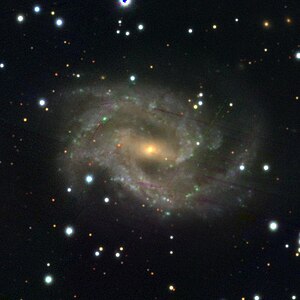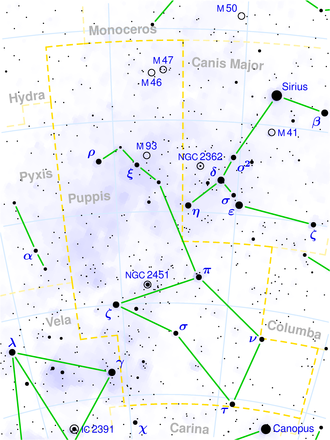NGC 2525
| Galaxy NGC 2525 |
|
|---|---|

|
|
| AladinLite | |
| Constellation | Aft deck of the ship |
|
Position equinox : J2000.0 , epoch : J2000.0 |
|
| Right ascension | 08 h 05 m 38.0 s |
| declination | -11 ° 25 ′ 37 ″ |
| Appearance | |
| Morphological type | SB (s) c / HII |
| Brightness (visual) | 11.6 mag |
| Brightness (B-band) | 12.3 mag |
| Angular expansion | 3.0 ′ × 2.0 ′ |
| Position angle | 75 ° |
| Surface brightness | 13.4 mag / arcmin² |
| Physical data | |
| Redshift | 0.005274 ± 0.000017 |
| Radial velocity | 1581 ± 5 km / s |
|
Stroke distance v rad / H 0 |
(62 ± 4) · 10 6 ly (19.1 ± 1.3) Mpc |
| history | |
| discovery | William Herschel |
| Discovery date | February 23, 1791 |
| Catalog names | |
| NGC 2525 • PGC 22721 • MCG -02-21-004 • IRAS 08032-1117 • 2MASX J08053803-1125372 • GC 1623 • H III 877 • h 486 • HIPASS J0805-11 | |
NGC 2525 is a bar-spiral galaxy with extensive star formation regions of the Hubble type SBc / P in the constellation Puppis in the southern sky . It is estimated to be 62 million light years from the Milky Way and about 35,000 light years in diameter.
The Type Ia supernova SN 2018gv was observed here.
The object was discovered by Wilhelm Herschel on February 23, 1791 .
